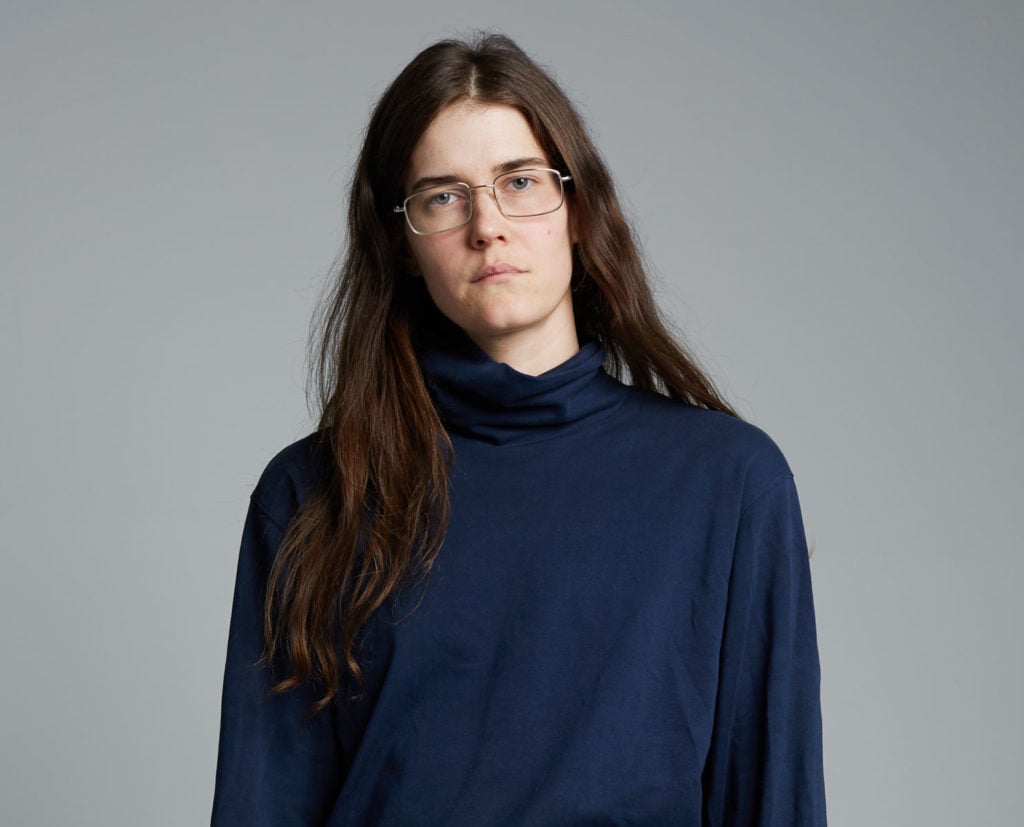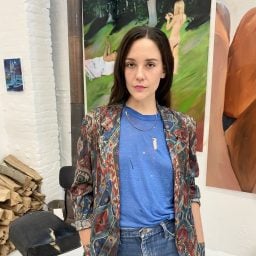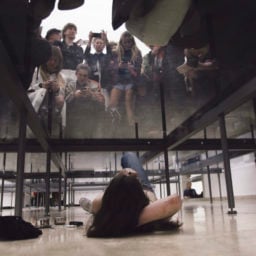You may not know the name Eliza Douglas, but you have likely seen her face. The 33-year-old artist is best known for her role in the confrontational, award-winning performance pieces created by her partner, the German art wunderkind Anne Imhof.
In that context, Douglas is the embodiment of European cool—tall and tattooed, t-shirt tucked into faded jeans, a pair of oversized glasses framing her androgynous face. Sometimes, she even plays a guitar or holds a falcon. But in person, a different character emerges: an awkward American, lanky and self-effacing, whose paintings embody the same qualities.
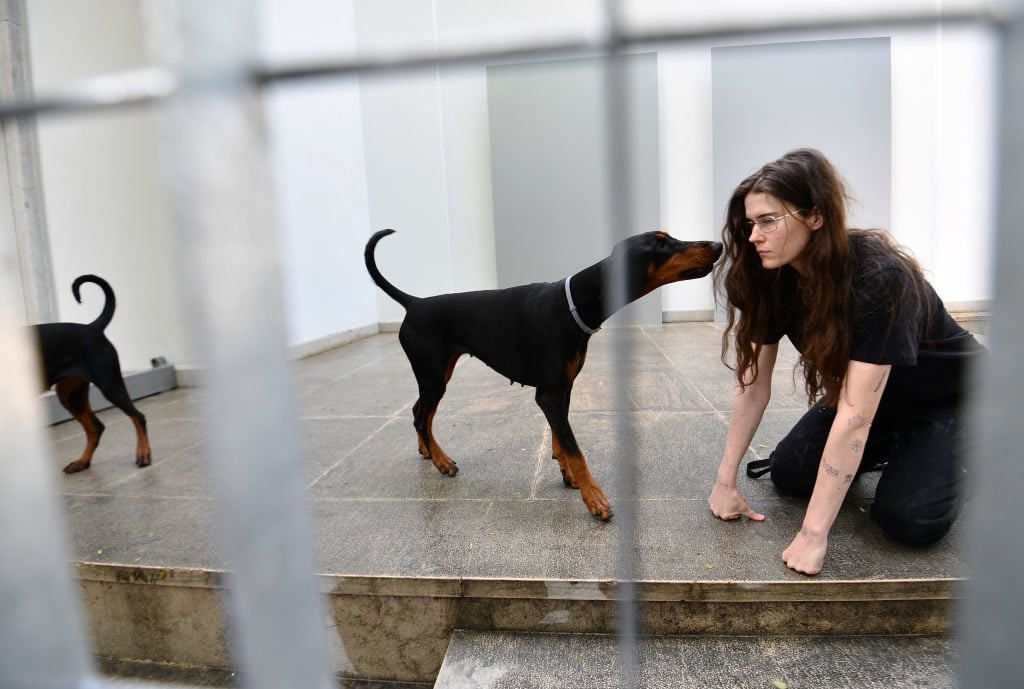
Eliza Douglas in Anne Imhof’s Faust at the 2017 Venice Biennale. Photo courtesy of Vincenzo Pinto/AFP/Getty Images.
Douglas and I met at the Jewish Museum, where her two new paintings hang in the lobby—her first museum presentation in the US. The paintings, titled Shadow and Light and Blood and Bones after lines in Dorothea Lasky poems, both feature a pair of hands connected to flimsy, elongated arms that wind around the outside of otherwise blank canvases. The hands are delicate and lifelike; the sleeves, sloppy and gestural.
“There’s a stark tension between the figurative and the abstract,” says Kelly Taxter, an associate curator at the Jewish Museum, who organized the show. “She forces you to think about the relationship between the two.”
An Auspicious Beginning
Taxter first met the artist in the late 2000s when she was in grad school at CCS Bard. Douglas was an undergrad on the same campus. She encountered her work again in 2017, when Douglas was included in a group show at James Fuentes Gallery in New York.
“I thought her paintings were mysterious and sort of funny,” she recalls. “There was a sense of irony that I couldn’t quite place. I wanted to know what was going on there.”
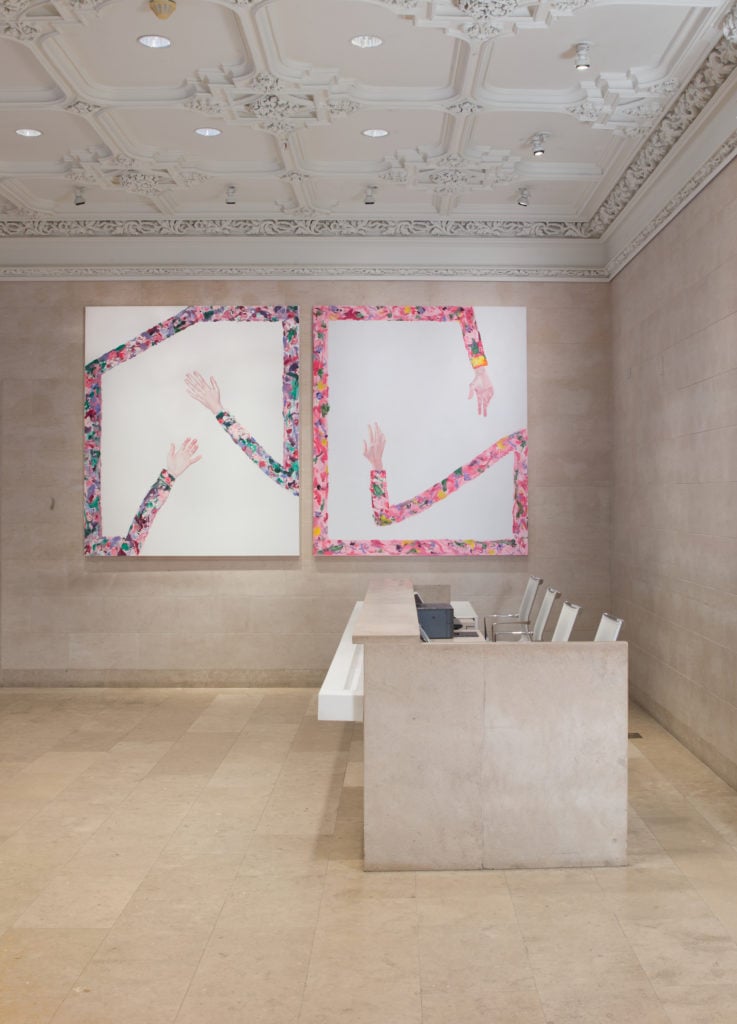
Installation view of the exhibition “Eliza Douglas,” May 4 – October 21, 2018, Courtesy of the Jewish Museum, NY. Photo: Jason Mandella.
Douglas did not make the paintings on view at the Jewish Museum alone. As she does for much of her work, she hired another painter to render the more detailed hands, while the sleeves are her own handiwork. In other cases, she has ordered entire compositions from Dafen, a village in China that produces more than half of the world’s paintings. (The majority are reproductions of canonized classics or hotel decorations.)
“Douglas’s work raises questions about authorship and how we value painting its connection to the artist’s hand, and our ability to understand the technical virtuosity,” Taxter says. “All these ways we’ve been taught to read painting, regardless of how conceptually situated it is, she kind of mucks with.”
All of this is high praise considering the relative newness of Douglas’s career. After all, she didn’t start painting in earnest until 2015.
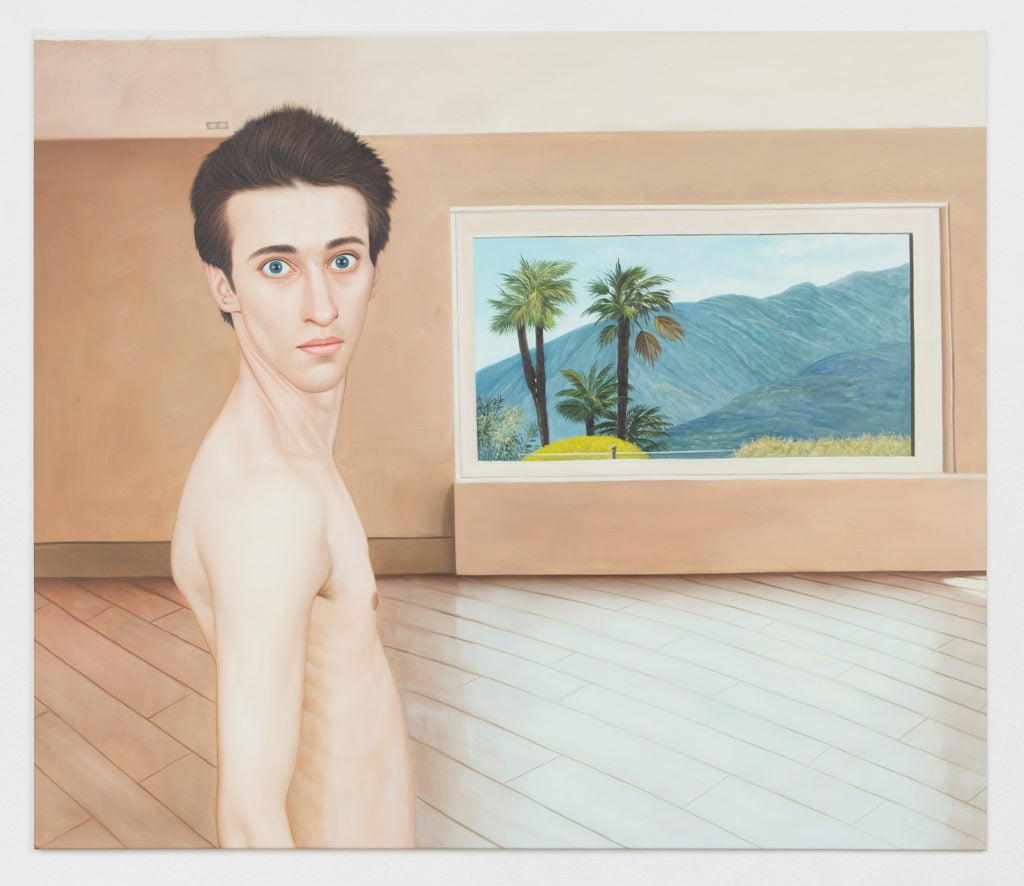
Eliza Douglas, Weird, the Real Kind (2) (2017). Courtesy of Air de Paris. Photo: Ivan Murzin.
Finding Her Footing
Douglas, a fifth-generation New Yorker, is the daughter of a lawyer and an elementary school teacher. She was born and raised in the West Village, in the same house where both her grandmother and father grew up. She hit her growth spurt at an early age and has been roughly the height she is now—over six feet tall—since then. She did some modeling when she was 13 and 14 for brands like Helmut Lang, but didn’t pursue it because of the constant rejection.
Inspired by a high school photo class, she decided to go to Bard, a school known for its photo department. Though, halfway through her second year, she was kicked out of the program for missing classes. It took her five years to finish undergrad. When she did, she jumped around to different day jobs—a waitress at a macrobiotic restaurant, a receptionist at a friend’s barbershop—and toured in several bands. She tried going back to school for social work, but eventually abandoned that too.
“I always sought out low-commitment and short-term jobs because I wanted to preserve the potential for being an artist,” Douglas tells artnet News. “But for many years I wasn’t able to get artistically unstuck. When I started getting close to 30, I freaked out, realizing that I wasn’t actually moving forward with the endeavor that I was supposedly designing my life around.”
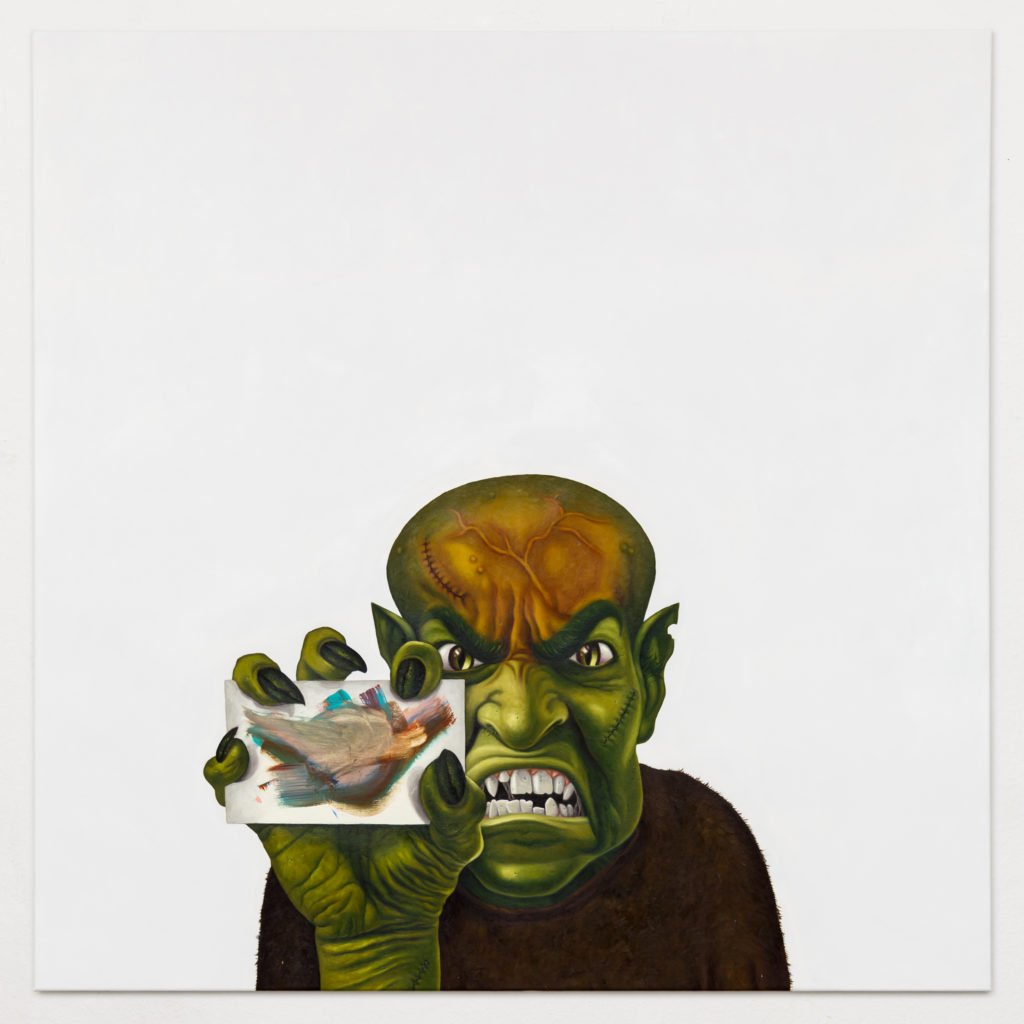
Eliza Douglas, I Am the Horse you Should Bet On (I) (2016). Courtesy of Air de Paris. Photo: Ivan Murzin.
In late 2014, hearing that many schools in Europe were free, she called a friend who had gone to the Städelschule in Frankfurt—one of the top art schools in the world, with a reputation for fostering experimental work. She set up a Skype date with a professor, painter Willem de Rooij. Then, with two weeks to go before the meeting, she got to work.
Douglas began painting abstract forms on random objects around her house—aluminum foil, found images, a set of Batman bed sheets—and photographed the results. She reproduced the images on small canvases using the kind of print-on-demand machines you find at CVS and Walmart, then painted over them again.
“I thought it was a good way to get a lot of decent-looking stuff made really quickly,” Douglas says now. “I was thinking about how I might be able to get him to think that I was doing something more elaborate than what I really was.”
It worked. de Rooij invited her to enroll.
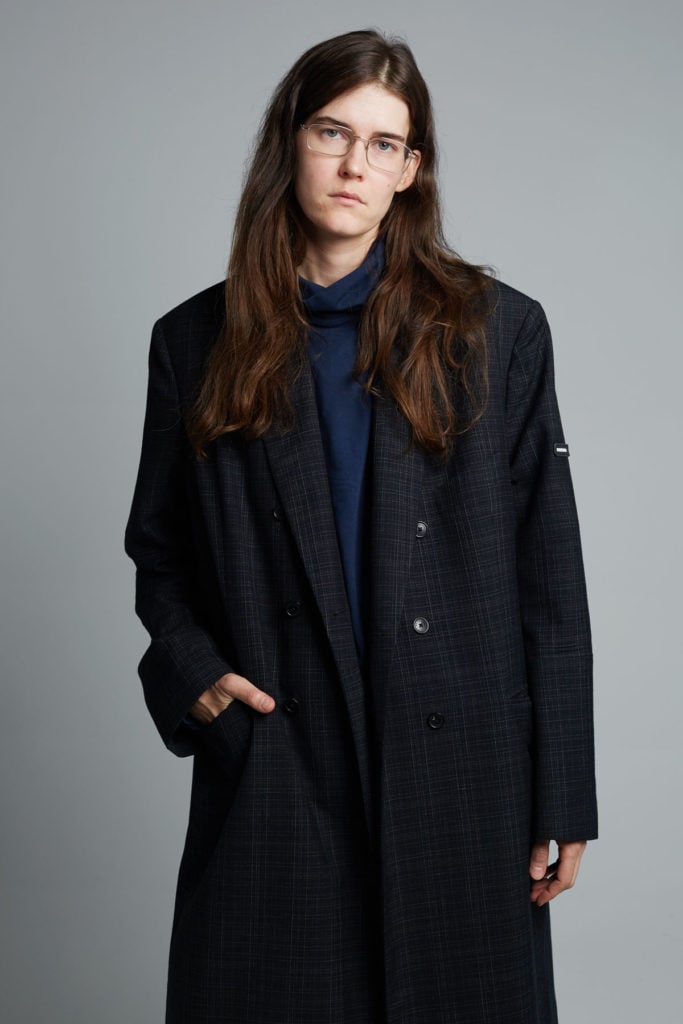
Eliza Douglas. Courtesy of the artist. Photo: Eva Goedel.
A Rapid Rise
Douglas’s first year would prove to be life-changing. For one, she met Imhof. It was the fall of 2015. They ran into each other in lobby of Texte zur Kunst’s 25th anniversary gala.
“I kind of had a crush on her from a distance,” recalls Douglas. “She invited me to see her show at the Hamburger Bahnhof, I went with her to the dinner afterword, then, in classic lesbian style, I basically moved in two days later. And the rest is herstory!”
The exhibition at Hamburger Bahnhof was the first and only one of Imhof’s shows that Douglas has seen as a spectator. She has performed in each and every one of Imhof’s subsequent pieces, including Faust, the German artist’s Golden Lion prize-winning presentation at the 57th Venice Biennale in 2017.
In the spring of 2016, Douglas showed her works for the first time. It was at the Städelschule’s “Rundgang”—an annual open house-style show produced by European art students. The event has a reputation for luring big-name collectors and curators and launching the careers of young artists. At the time, Douglas’s own expectations were low.
“I had my own little studio in this weird space there where I installed a painting show,” she recalls. But she sold several works, and a couple of weeks later, one particularly enthusiastic buyer (who happened to be on the school’s board) introduced her to an friend, Florence Bonnefous, the co-owner of Air de Paris gallery in the French capital. Bonnefous offered her a solo show that fall.
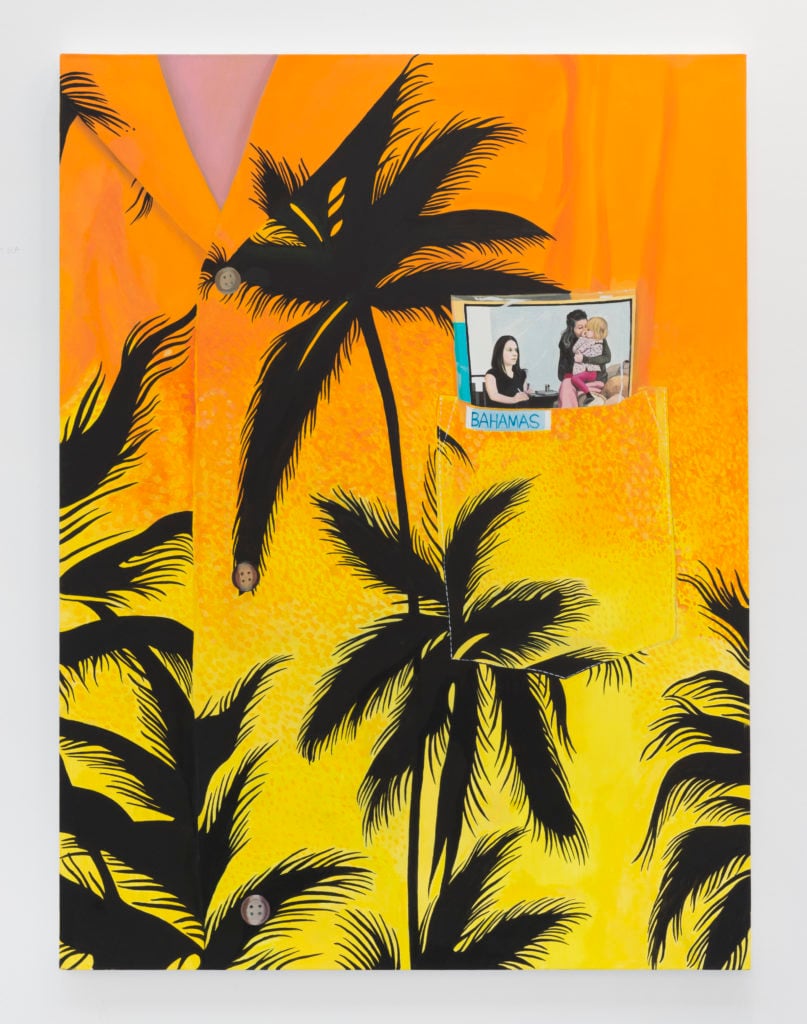
Eliza Douglas, Untitled (2017). Courtesy of Air de Paris. Photo: Marc Domage.
.
Suddenly, other opportunities opened up. Within a year and a half of starting school, Douglas had a half-dozen solo shows on the calendar, including three at museums, and gallery representation on two continents. She was also, of course, dating one of Europe’s biggest art stars and performing in the Venice Biennale.
After graduating last year, Douglas is now in the process of moving back to New York. Imhof will join her, splitting time between the US and Frankfurt.
However, from a technical standpoint, Douglas is still not a good painter. And she’ll be the first to admit it. Instead, she’s stumbled into conceptual territory, grappling with the production, circulation, and commodification of painting in the 21st century.
“It’s a very simple idea,” Taxter says. “It allows the work to have different ways of being looked at and talked about. That’s a hard thing to do with painting; it’s a tough field to insert something new. And she’s done it with ease. And because she hasn’t been an artist for a long time, she comes to it in a fresh way. It’s like she’s entered through a slide door, so to speak.”
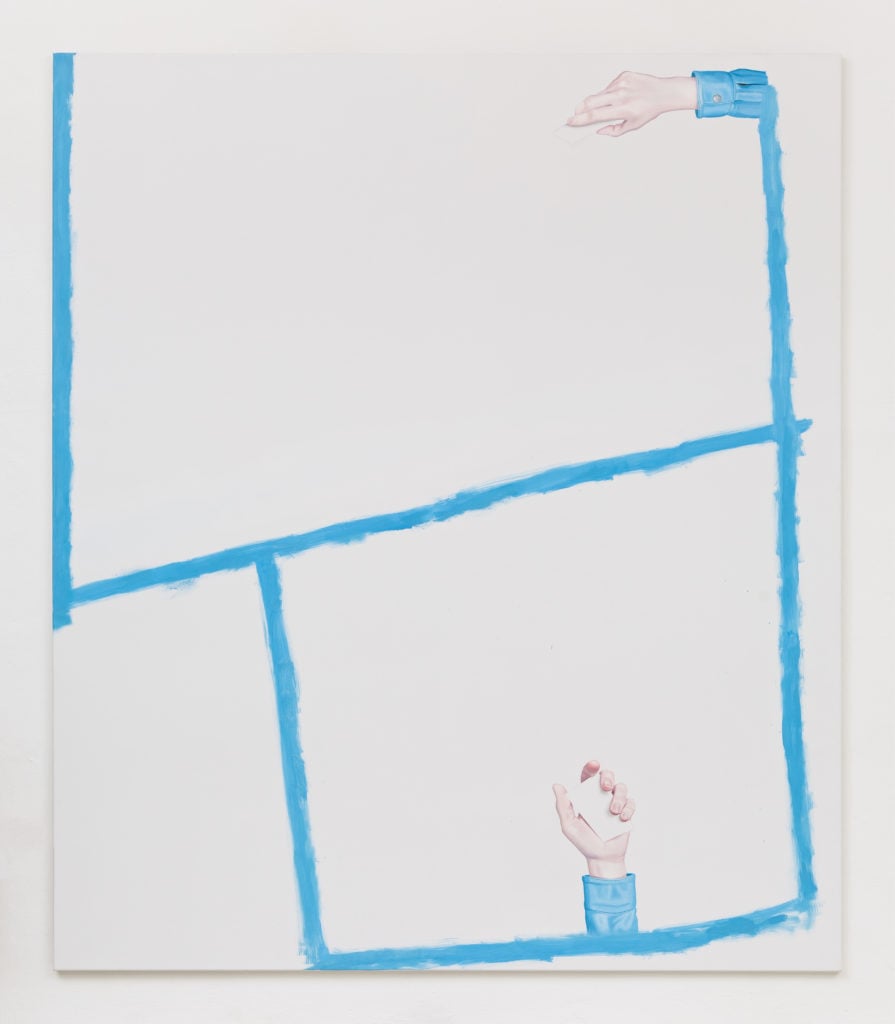
Eliza Douglas, Music and Mathematics (2017). Courtesy of Air de Paris. Photo: Ivan Murzin.
“Eliza Douglas” is on view at the Jewish Museum through October 21, 2018.
